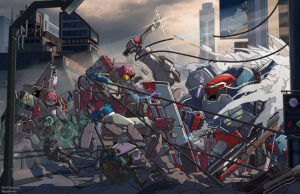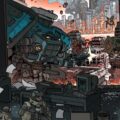 For 500 years, the planet Cressidium has been isolated from the wider galaxy. Turned from a fledgling colony into a refuge for those fleeing from the fall of the Second Committee, the people of Cressidium have struggled and fought to build a home for themselves while casting off the shadow of SecComm’s tyranny. Five centuries later, an encounter with a Union exploratory mission has ignited an interest in rejoining the galactic community, but not everyone on Cressidium sees the Third Committee as potential allies, but rather usurpers of humanity’s rightful legacy among the stars. Now, the arrival of a Union diplomatic delegation may be the spark that causes simmering tensions between nations to erupt into all-out war.
For 500 years, the planet Cressidium has been isolated from the wider galaxy. Turned from a fledgling colony into a refuge for those fleeing from the fall of the Second Committee, the people of Cressidium have struggled and fought to build a home for themselves while casting off the shadow of SecComm’s tyranny. Five centuries later, an encounter with a Union exploratory mission has ignited an interest in rejoining the galactic community, but not everyone on Cressidium sees the Third Committee as potential allies, but rather usurpers of humanity’s rightful legacy among the stars. Now, the arrival of a Union diplomatic delegation may be the spark that causes simmering tensions between nations to erupt into all-out war.
Caleb as callsign GALILEO
Maddy as callsign DAYBREAK
Chris as callsign CATALYST
Podcast: Play in new window | Download (Duration: 3:13:00 — 88.6MB)
Subscribe: RSS






Cool to see you folks come back to this system. I figured that despite having a buncha neat mechanics and worldbuilding elements it’s still a wargame disguised as a ttrpg and wouldn’t quite fit the format. The Solstice Rain maps are full of enough varied terrain that despite not knowing relative positions of characters I didn’t feel too lost, akin to a mech show in space combat. Relative positions are less important than who is engaging with who. While Caleb’s narrative sections of Siege of Vermeer were a delight I do appreciate how you folks sped through the crunch of more of a combat focused module. The group I play with can take a while to handle turns and despite regularly looking up rules you 4 breezed through this at a quick pace.
Found it funny when Chris expressed wanting a points system for actions to keep track of things when that’s kinda what’s going on. Everyone’s turn is two Action Points, and a Standard Move and Protocols at the start of the turn. Everything you can do is 1 or 2 Action Points(technically not how it works since Overcharge gives you a free action Quick Action and not an Action Point that can be spent on a 2 Action Point Full Action, but most tables don’t care that much). Standard Move isn’t an Action Point so can’t be sacrificed for 3 Action Points in a single turn. Pretty much the only thing that takes this away as an option is the Immobilized status. Slowed just prevents all movement options except this Standard Move. Right now that isn’t much but is important on some equipment, talents, and notable NPCs.
Maddy’s confusion over loading is a fair observation, it’s a lil weird in this system. Reloading is primarily done through the Stabilize action, a Full Action. To fire the AMR they had takes a Quick Action. Barring using the mech’s Initiative 1/fight to Skirmish or Overcharging for increasing heat to do the same, the rhythm of loading is skirmish/barrage to fire 1/2 weapons, next turn Stabilizing as a Full to reload all loading weapons, turn after that being able to Skirmish/Barrage again. Loading is a big part of a weapons power budget that assumes that badboy will only be used once every other turn, so finding ways to live with Stabilizing taking up a full turn at the right time can be lucrative. Ranges from firing a loading weapon and doing something else until you were going to Stabilize for health/heat anyway to mounting a loading weapon on every mount and going ham, since Stabilize reloads all of them at once.
Caleb brushed into a pain point of low License Level combat of not having many sources of accuracy and the math being built around rolling a d20 around a target of 10. There are a few tools around this such as Lock On, a Quick that adds Accuracy to a future attack that consumes the inflicted Lock On status. You can think of this like an aim action in other systems giving up some action economy for better odds of hitting. Using the Ram action can knock a character Prone which makes all attacks against that character have Accuracy until they stand up. There are a few things that instead of rolling an attack cause a target to roll a Save, and unless that NPC type particularly excels at that stat it’s pretty good odds(though as noticed the d6 damage of the GMS grenade isn’t the most exciting thing). Some weapon types have Talents that add Accuracy to their attacks in certain contexts, CQB weapons like the shotgun in range 3, Main size melee weapons, Rifles if you Immobilize yourself, Aux size ranged weapons. Real powerful archetypes tend to not have easy access to Accuracy to balance their power like heavy ranged and melee, cannons and launchers. And most notably Reliable weapons like the GMS Assault Rifle and superheavy weapon Cyclone Pulse Rifle. On a miss they still deal their Reliable value as damage.
Despite things that went well or poor this game kinda fits the intended attrition the system is designed around. Players are intended to get beat up and suffer Structure damage they have to spend Repairs on. The closer players are to running out of Repairs the tenser and more dramatic the mission. Players spending 1-2 repairs a fight and succeeding a mission with one or two mechs wrecked is ideal. If a mission ends with everyone holding onto half their repairs and only missing 1 structure they can be pushed a lil harder.
Enjoyed the episode and despite the confusion and general complexity of the mechanics I hope the players enjoyed something a lil crunchier too. I fear this isn’t quite the genre that fits your format but it turned out better than I expected.
very insightful critique of the game and system! I agree Lancer doesn’t quite fit our AP structure but I thought it was worth trying again.
Ross: Have you looked at Beam Saber? I haven’t played it myself so I can’t speak from personal experience, but its a FitD game, which I know RPPR crew has experience with.
Oops, forgot to include this link: https://austin-ramsay.itch.io/beamsaber
I am aware of beam saber but I haven’t read the rules yet. I also found out about a new mecha RPG called Salvage Union that seems very interesting.
Huh, hadn’t heard of it before. Looking at the quickstart rules, I do recognize Alex Connolly’s art; I used to follow him on twitter.
Maybe for Chris there’s a fan-made combat flowchart out there that could help better than the “quick combat reference” in the rulebook does, because Lancer’s “action economy” is pretty complicated. I’ve played other mecha wargames (BattleTech; Heavy Gear; Mobile Frame Zero) and Lancer’s turn sequence looks more complicated than any of them (though people do sometimes have trouble with MFZ’s tactical order/combat order sequence). But otherwise I suspect that it’ll be a matter of reading through the “mech combat” section and trying to internalize all of those rules.
I was thinking of saying more about homework and “challenge” type games, but I think the laundry list of ways of building up bonuses that Blind Duke talked about does a pretty good job of showing that Lancer is a game where you really have to study the rulebook to get the reward of assuring success when you roll the dice.
So I started reading Salvage Union and I’m seeing the words: “nuclear reactor powered Mechs”; “lance”; “Heat”
*sigh*
System mastery and rules understanding is certainly an aspect. Though mastery in this system is idealized since no equipment/talent choice was made to be weaker as a player test. For a person who dislikes missing there are directions to go to either increase one’s chances to hit or contribute without having to make an attack roll. Going in the opposite direction is just as fine, since the inaccurate options are twice as potent(and maybe more so) to balance it out. If you hit half as often it still works out.
The system having mechs and a want for narratives of parts blowing off in battle asks for a solution to essentially being taken out of the fight. In certain systems being taken out real fast can be part of the appeal. In this one even a mech built around using its melee weapon having its sword broken has a buncha options to stay relevant. From using your melee bulk to get in there and grapple enemies to be easier for your friends to hit to throwing out lock on’s and invade status effects. The Grunt template goes down to any damage so your tertiary weapons taken as backup can plink away at grunt enemies while your buddies with heavy weapons can go for more durable targets. One can be scrappy and improvisational in the combination of to-hit numbers being fairly low for many NPC types and many options you have which don’t even need to roll. Won’t feel as impactful as rolling 3d6 to melee that named recurring enemy but that’s a tall ask.